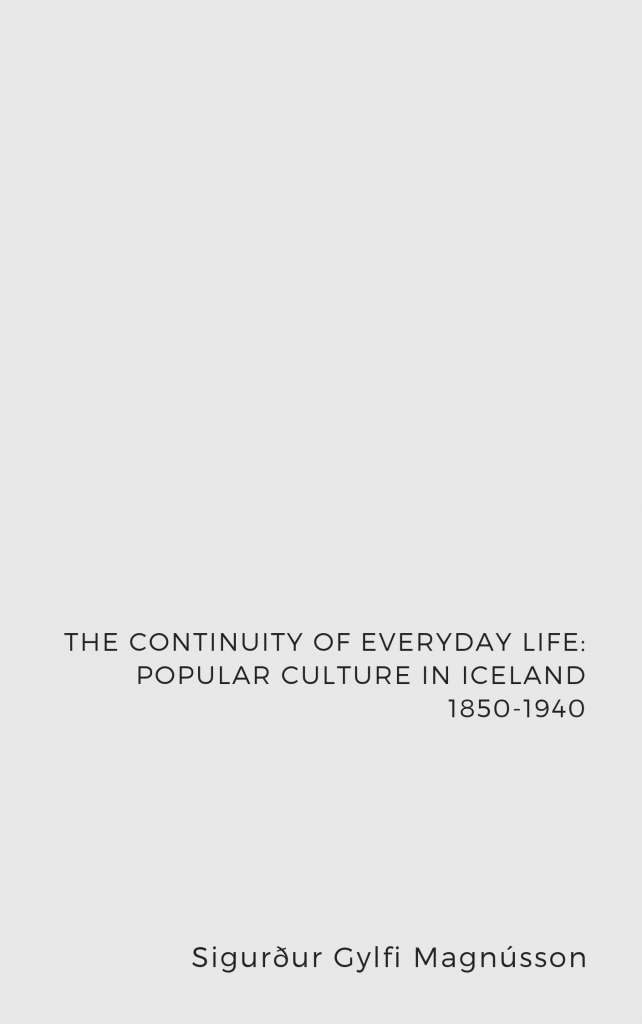 The Continuity of Everyday Life: Popular Culture in Iceland 1850-1940. Doctoral dissertation, Carnegie Mellon University, USA, 1993. 416 pages. Committee: Dr. Peter N. Stearns, Dr. John Modell, & Dr. Mary Lindemann.
The Continuity of Everyday Life: Popular Culture in Iceland 1850-1940. Doctoral dissertation, Carnegie Mellon University, USA, 1993. 416 pages. Committee: Dr. Peter N. Stearns, Dr. John Modell, & Dr. Mary Lindemann.
This dissertation deals with the changes in the Icelandic society in the late nineteenth century and early twentieth century. It is argued that in spite of some structural changes in Iceland at the time, peoples everyday experience actually changed remarkably little neither in the rural nor in the urban society. The focus is at the beginning on the Icelandic rural nineteenth century society where individual experience is drawn out from birth into adulthood. (The conceptual framework is around life-course analysis). The question is how was it to be raised up in this society and what kind of child-developmental stages did every individual go through? How did work and education actually affect people perception of life and how they grew up as individuals?
It is argued that most children went through unusual hardship from an very early age. They were constantly faced with the threat of death of close relatives and friends from the moment that they started to recall their first memories. This considerably affected their outlook on life in addition to the fact that they had little or inconsistent emotional support from their closest family (parents). From the age of five or seven children were given tasks which they usually had to exicute on their own. Heavy workload and often great responsibility still added to their misery. But their salvation between the age of five and seven to approximatly ten years old was education. Their intense interest in education in this traditional society indicated that they used the Icelandic sagas to escape daily reality and into imaginary world of this rich literature. Education became in this sens their moral authority where they looked for guidance and models to conduct their life in the absens of their parents emotional support. This interaction beteen work and education made literacy rates unusually high in Iceland.
Later on, between age of ten and fourteen, the role of work and education was reversed. Children started to see the world and themselves through work. A participation in the work process did then not only increasingly become a physical necessity for the family economy, but also, it benefited children psychologically. The work was a mirror of their own existence, which allowed them to situate themselves in the home and in their general surroundings. Working with adults became the relief which they had got previously with education. Education on the other hand was incresingly focused on religious texts as a preperation for the confirmation. These texts children had to memorize by heart, and it became a distraction from their important work participation. Along with that came the pressure which they felt from all angles of the society and was focused in the confirmation ceremony itself, which was like a magic entry into adulthood. In short: we notice the absens of adolescence in the Icelandic rural nineteenth century society, because children were increasingly introduced to adult standards.
The period which was ahead, adulthood (fourteen to marriage), was often seen as providing an opportunity to repay the parents for their physical and mental support during their late childhood. This is interesting considering the fact that the parents-children relationship was often seen as distant and cold by children but the importance of work is mirrored in their yearning for supporting their parents. But the expectation to repay for parents support often caused a major tension between parents and children at this age, because it often tied them down on their parents farm. That meant that they often had to postpone their plans to get further education or to exploits some of the changes in life.
By following childrens development in the peasant society we notice a formations of two groups of distinct perosnalities. The first one was a group of very strong and independent individuals who are willing and eager to walk against their destiny with certain calm and dignity like their ancestors from the Icelandic saga. The second one contaned individuals who had a very hard time dealing with reality at large. What determined this distinction was how much emotional support children got in their early years and their social position in general.
After analyzing the everyday life experience in the nineteenth century rural society (with the help of very rich autobiographical sources) a comparison is made with the early twentieth century urban society. We see that children by their nature are a vehicles of continuity from one generation to the next (the values which they are tought) but at the same time they are the group of people who are most able to adapt to change between generations. So, despite of changes in the society like urbanization, growing mechanization, and changing class structure, there is a definite continuity in the way how ordinary people conducted their everyday life in the urban twentieth century society as it is manifested in their attitude towards work and education.
The life-course was in its basics features the same in the rural and the urban society and is most likely one of the key reasons that Iceland changed form an extremely poor peasant society into one of the most successful Western societies over a relatively short period of time. Icelandic historians have labeled this period as the revolutionary era, a period where basically every aspect of the society underwent major changes. This convencual wisdom is challange in this dissertation. As a matter of fact it is argued here that broad aspects of the popular culture was less dependent upon demographic and economic factors than most historians claim. And that is exactly the reason that the Icelandic society made the transition towards modern society so smoothly.
